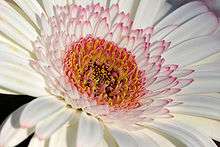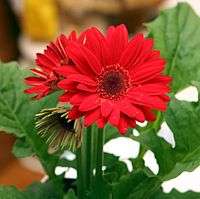Gerbera
| Gerbera | |
|---|---|
 | |
| A white Gerbera × hybrida | |
| Scientific classification | |
| Kingdom: | Plantae |
| (unranked): | Angiosperms |
| (unranked): | Eudicots |
| (unranked): | Asterids |
| Order: | Asterales |
| Family: | Asteraceaey |
| Subfamily: | Mutisioideae |
| Tribe: | Mutisieae[1] |
| Genus: | Gerbera L. 1758 non Boehmer, 1760 (Asteraceae) nec J.F.Gmel., 1791[2] |
| Synonyms[1] | |
| |
Gerbera (/ˈdʒɜːrbərə/ or /ˈɡɜːrbərə/) L. is a genus of plants Asteraceae (daisy family). It was named in honour of German botanist and medical doctor Traugott Gerber[3] | (1710-1743) who travelled extensively in Russia and was a friend of Carl Linnaeus.[4]
Gerbera is native to tropical regions of South America, Africa and Asia. The first scientific description of a Gerbera was made by J.D. Hooker in Curtis's Botanical Magazine in 1889 when he described Gerbera jamesonii, a South African species also known as Transvaal daisy or Barberton Daisy. Gerbera is also commonly known as the African Daisy.
Gerbera species bear a large capitulum with striking, two-lipped ray florets in yellow, orange, white, pink or red colours. The capitulum, which has the appearance of a single flower, is actually composed of hundreds of individual flowers. The morphology of the flowers varies depending on their position in the capitulum. The flower heads can be as small as 7 cm (Gerbera mini 'Harley') in diameter or up to 12 cm (Gerbera ‘Golden Serena’).
Gerbera is very popular and widely used as a decorative garden plant or as cut flowers. The domesticated cultivars are mostly a result of a cross between Gerbera jamesonii and another South African species Gerbera viridifolia.[5] The cross is known as Gerbera hybrida. Thousands of cultivars exist. They vary greatly in shape and size. Colours include white, yellow, orange, red, and pink. The centre of the flower is sometimes black. Often the same flower can have petals of several different colours.
Gerbera is also important commercially. It is the fifth most used cut flower in the world (after rose, carnation, chrysanthemum, and tulip). It is also used as a model organism in studying flower formation.
Gerbera contains naturally occurring coumarin derivatives. Gerbera is a tender perennial plant. It is attractive to bees, butterflies and/or birds, but resistant to deer.[6] Their soil should be kept moist but not soaked.
- Species[1]
- Gerbera ambigua
- Gerbera aurantiaca : Hilton Daisy
- Gerbera bojeri
- Gerbera bonatiana
- Gerbera connata
- Gerbera cordata
- Gerbera crocea
- Gerbera curvisquama
- Gerbera delavayi
- Gerbera diversifolia
- Gerbera elliptica
- Gerbera emirnensis
- Gerbera galpinii
- Gerbera gossypina
- Gerbera hypochaeridoides
- Gerbera jamesonii : Barberton Daisy, Gerbera Daisy, Transvaal Daisy
- Gerbera kunzeana
- Gerbera latiligulata
- Gerbera leandrii
- Gerbera leiocarpa
- Gerbera leucothrix
- Gerbera lijiangensis
- Gerbera linnaei
- Gerbera macrocephala
- Gerbera maxima
- Gerbera nepalensis
- Gerbera nivea
- Gerbera parva
- Gerbera perrieri
- Gerbera petasitifolia
- Gerbera piloselloides
- Gerbera pterodonta
- Gerbera raphanifolia
- Gerbera ruficoma
- Gerbera saxatilis
- Gerbera serotina
- Gerbera serrata
- Gerbera tomentosa
- Gerbera viridifolia
- Gerbera wrightii
- Formerly included[1]
Numerous species once considered members of Gerbera are now regarded as more suited to other genera: Chaptalia, Leibnitzia, Mairia, Perdicium, Trichocline, and Uechtritzia.
 Gerbera viridifolia
Gerbera viridifolia Gerbera jamesonii
Gerbera jamesonii- Gerbera × hybrida
 Red Gerbera Daisies
Red Gerbera Daisies Gerbera with pink and white ray florets
Gerbera with pink and white ray florets Gerbera jamesonii in Orange
Gerbera jamesonii in Orange
References
- 1 2 3 4 Flann, C (ed) 2009+ Global Compositae Checklist
- ↑ Tropicos search for Gerbera
- ↑ Gerbera.org
- ↑ Sunset Western Garden Book, 1995:606–607
- ↑ Isabel Johnson. "Gerbera jamesonii Adlam". Retrieved 22 January 2014.
- ↑ http://njaes.rutgers.edu/deerresistance/
- Hansen, Hans V. A taxonomic revision of the genus Gerbera (Compositae, Mutisieae) sections Gerbera, Parva, Piloselloides (in Africa), and Lasiopus (Opera botanica. No. 78; 1985), ISBN 87-88702-04-9.
- Nesom, G .L. 2004. Response to "The Gerbera complex (Asteraceae, Mutisieae): to split or not to split" by Liliana Katinas. Sida 21:941–942.
- Bremer K. 1994: Asteraceae: cladistics and classification. Timber Press: Portland, Oregon.
External links
| Wikimedia Commons has media related to Gerbera. |
- Gerbera.org—official website of the Gerbera Association—established in Barberton, South Africa
- Traugott-Gerber-Museum, Germany (German)